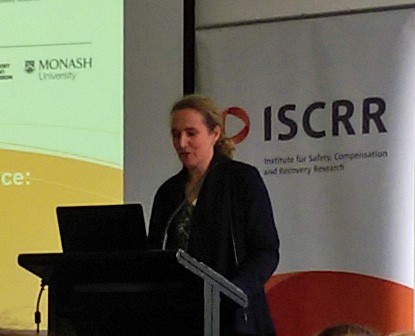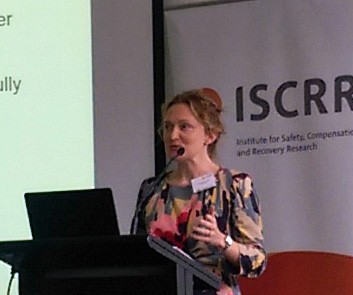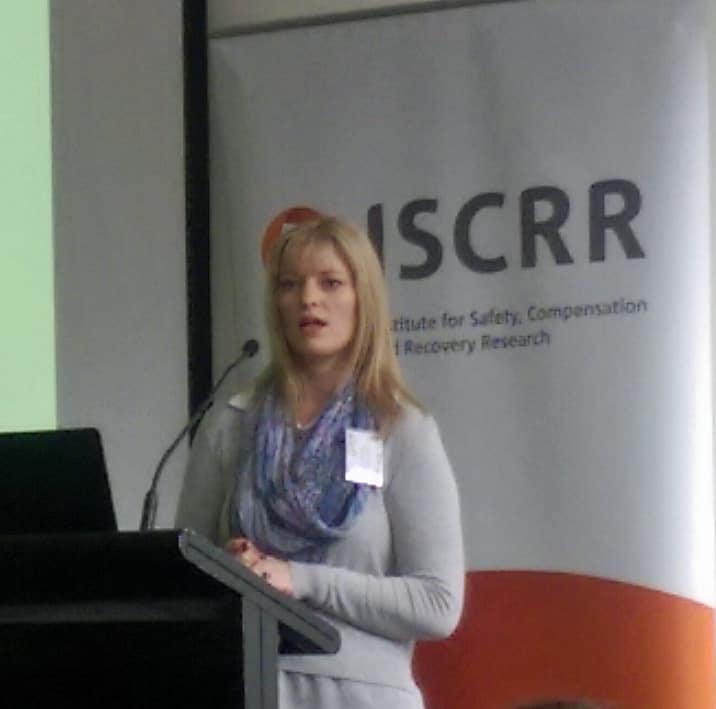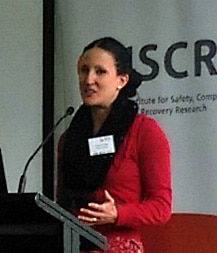
The Institute for Safety, Compensation and Recovery Research (ISCRR) has tried a new format for its occupational health and safety (OHS) seminars. It is not a lunch with a single presenter and it is not a Three-Minute Thesis. It is five safety researchers in one hour, seven minutes per person and a single question from the floor – and it worked.
These are the five researchers from today’s “If I Could Say One Thing” seminar.
- Dr Catriona Fraser of WorkSafe Victoria spoke about software that allows for the rapid analysis of large data sets.
- Dr Dianne Sheppard discussed the analysis of individual experiences in the return-to-work process.
- Rose Bryant-Smith spoke of the significance of middle managers in the prevention and management of workplace bullying an incivility.
- Dr Carlyn Muir outlined the injury research she is undertaking in the emergency services with particular focus on the Country Fire Authority.
- Dr Sharon Newnam discussed her research and impediments to the her research into the safety of work vehicle drivers.
Some struggled with the seven minute format, particularly when a hand bell was used as a time warning, but others were unfazed. Significantly none took the opportunity to sell anything – a rare thing on the seminar circuit.
 Dr Di Sheppard (pictured right) emphasised the importance of listening to the injured worker/client. Sheppard said that the injured client can offer the “best insight into barriers, attitudes and expectancies” and that the expectations of the injured worker provide the best early predictor. In some ways this was reminiscent of the Grandjean’s ergonomic principle of fitting the system (task) to the person (man) rather than vice versa.
Dr Di Sheppard (pictured right) emphasised the importance of listening to the injured worker/client. Sheppard said that the injured client can offer the “best insight into barriers, attitudes and expectancies” and that the expectations of the injured worker provide the best early predictor. In some ways this was reminiscent of the Grandjean’s ergonomic principle of fitting the system (task) to the person (man) rather than vice versa.
Sheppard also spoke about the need to use social networking to reduce feeling so isolation in the client and to encourage (re) socialisation. Not surprisingly some of this is being developed into an app.
 Worklogic’s Rose Bryant-Smith (pictured right) raised several issues about managing workplace bullying. The most significant was that a lot of productivity impacts occur in companies prior to the lodgement of any bullying claim or notification of bullying to the employer. These impacts include increased absenteeism and reduced labour productivity. Accepting this supports the importance of the organisational cultural and managerial matters of bad behaviour, incivility and disrespect. The use of these readily understandable terms in relation to bullying precursor was also of note.
Worklogic’s Rose Bryant-Smith (pictured right) raised several issues about managing workplace bullying. The most significant was that a lot of productivity impacts occur in companies prior to the lodgement of any bullying claim or notification of bullying to the employer. These impacts include increased absenteeism and reduced labour productivity. Accepting this supports the importance of the organisational cultural and managerial matters of bad behaviour, incivility and disrespect. The use of these readily understandable terms in relation to bullying precursor was also of note.
Bryant-Smith emphasised the role of middle managers in this process saying that those at higher levels are often too far removed from the workplace for interventions to be effective.
 Emergency services frequently run on a quasi-military organisational structure. This seems to provide an effective structure for organisations that are able to send considerable time and resources training their employees and operate in situations where quick assessments and decisions are required, often in tense or high-risk environments.
Emergency services frequently run on a quasi-military organisational structure. This seems to provide an effective structure for organisations that are able to send considerable time and resources training their employees and operate in situations where quick assessments and decisions are required, often in tense or high-risk environments.
SafetyAtWorkBlog asked Dr Carlyn Muir (pictured right) about how that structure has affected the OHS interventions and the transferability of the interventions from this environment to the non-emergency services realm. Dr Muir acknowledged that there is a different culture between employed members of the Country Fire Authority and the volunteers and this must be considered when developing OHS and risk programs.
 Dr Sharon Newnam (pictured right) was probably the speaker whose content was the most challenging; not that it was difficult to understand but that it challenged existing processes and concepts. Dr Newnam’s research is focusing on the road transport network and drivers. Outside of New South Wales, many Australian States are struggling to accept that trucks are workplaces and that driver actions can be subject to work health and safety laws.
Dr Sharon Newnam (pictured right) was probably the speaker whose content was the most challenging; not that it was difficult to understand but that it challenged existing processes and concepts. Dr Newnam’s research is focusing on the road transport network and drivers. Outside of New South Wales, many Australian States are struggling to accept that trucks are workplaces and that driver actions can be subject to work health and safety laws.
One of the barriers to change in this area is jurisdictional arguments. Dr Newnam used the Victorian situation as an example. A truck incident could be referred to either the Transport Accident Commission or WorkSafe Victoria and both agencies have referred safety matters and incidents to the other. The end result is that the injured truck driver’s rehabilitation, or compensation, is unnecessarily complicated and probably prolonged.
She asked three simple, poignant questions:
- To regulatory bodies – Who has jurisdiction?
- To organisations – Who is responsible for the drivers?
- The the driver – Who is to blame for the crashes?
Such questions are often “resolved” by lawyers but these need to be considered as part of existing transport business management by business owners, drivers and safety professionals well before any incident occurs.
ISCRR’s seminar format was well received by the 90 people attending the free OHS seminar. The challenge will be to maintain the quality of the speakers.
